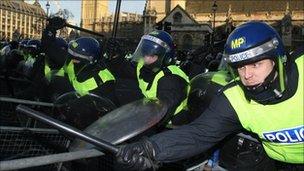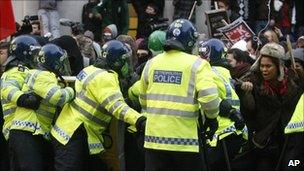Police 'kettle' tactic feels the heat
- Published

Police say kettling is a safe way of controlling crowds which may contain individuals bent on violence
Police attempting to control student demonstrators in London have resorted to controversial "kettling" techniques to contain the protest.
Used effectively at the G20 summit in London in April 2009, kettling has developed as the Metropolitan Police's tactic of choice when it comes to controlling large and potentially violent protests.
But how does it work and why is there opposition to it?
The word derives from the German word "kessel" - literally a cauldron, or kettle - to describe an encircled army about to be annihilated by a superior force. For soldiers within the kettle the situation would soon become unbearable hot.
For police officers, the kettle has a different end but the tactic remains the same - containment and control.
Writer and director Zia Trench was caught in a "kettle" at the G20 demonstration in the City of London.
"I wasn't sure if I wanted to protest but I thought I'd check out the demonstration and show my face for half an hour," she said.
"As I walked out of Cannon Street Tube I literally found myself facing a line of police. When I asked if I could get through, the police refused. They then moved me down the street towards the Bank of England."
There, Ms Trench joined a growing group of protesters corralled within a circle of police in the square in front of the Bank.
Held by the police within the circle for up to seven hours, the protesters found themselves trapped.
"We were completely surrounded - we couldn't get out and after a while the police stopped other people getting in," Ms Trench said.
Writing in the Times, former senior Met officer Andy Hayman described how kettling worked:
"The tactics are "to herd the crowd into a pen, known as 'the kettle'... the police will not want groups splintering away from the main crowd."
Policing experts say the procedure dictates that officers move protesters to a pre-designated spot. As other protesters join the crowd, the police noose draws gradually tighter.
Eventually protesters find themselves surrounded by police specially trained in crowd control. Mounted police can also provide backup.
Police may occasionally relieve some of the pressure on the kettle by allowing people to leave - but officers are constantly seeking to maintain control and this is via a designated route.
However, anyone determined to stay may be held for hours without access to food and water.
During the G20 events, protesters reported having to relieve themselves in the street because they had no access to toilets.
In recent weeks students protesting against an increase in tuition fees have complained about being beaten with batons and the police moving them around from exit to exit with the aim of tiring them out.
They said their strategy was to avoid being contained by police.
Eventually, say the police, most [protesters] get fed up and agree to depart peacefully.
At the G20 protest, police were criticised after it was alleged that demonstrators who refused to be photographed and give their names and addresses were put back into the pen.
Kettling has already been unsuccessfully challenged in the courts on the grounds that it constitutes false imprisonment and that it contravenes freedom of movement.
Police defence
But police defend it, arguing that the tactic provides an efficient and relatively safe way of controlling crowds which may contain individuals bent on violence.
Revealingly, the use of the word kettling differs depending on which side of the police line you stand.
Security expert Mal Geer of Prime Media, a firm instructing journalists how to cope in riot situations, says kettling is so called because "it takes the steam out of a potentially violent situation".

Students protesting against tuition fee increases say kettling exacerbates violence
But a G20 protester had a different interpretation: "Kettling means keeping people inside an area until they are boiling with rage."
Liberty director Shami Chakrabarti, agrees: "We have serious concerns about "kettling" human beings in difficult situations....
"Imprisoning them in this way risks making people angry, making them desperate and exacerbating any risk to public safety," she has told the BBC.
Students demonstrating in London over tuition fees have blamed kettling for exacerbating violence.
Even defenders of the tactic acknowledge it is not without risk.
"Officers find themselves incredibly up-close and personal with people who are yelling abuse and trying to get out," said one former officer.
"Inevitably, tempers get frayed. You can imagine that it wouldn't take much of a spark to light the fuse."
But the Met stresses all officers are bound by strict guidelines laid down by the Association of Chief Police Officers.
For example the police standard weapon - the baton - can be used, but only if its use is "proportionate to the level of threat".
Additionally, "The decision to strike is for the individual officer and must be justified by them in each instance."
Court challenge
Accused by protesters of restricting the right of protest and free movement, police kettles have already faced a challenge in the courts.
At a May Day protest in 2001, Lois Austin and 3,000 fellow demonstrators were held within a police cordon in Oxford Street for seven hours.
Although Ms Austin claimed damages for false imprisonment and unlawful detention, her case was dismissed by High Court, the court of appeal and the House of Lords.
It found her treatment did not violate her right to liberty if the measures were used in good faith, were proportionate and were enforced for no longer than was reasonably necessary.
After the G20 protests, Scotland Yard ordered a review of the tactic, following the death of newspaper vendor Ian Tomlinson, who had been struck by a police officer in a "kettle".
The Independent Police Complaints Commission advised the Met to to review its crowd control methods, including the tactic of kettling.
Her Majesty's Chief Inspector of Constabulary, Denis O'Connor, described the kettling technique as "inadequate" and belonging to a "different era" of policing.
However, he did not suggest that kettling should be abandoned - rather the methods must be adapted so that peaceful protesters and bystanders are able to leave the kettle.
With legal backing from Britain's highest court, together with the belief among law and order professionals that containment is the "least worst" option, it could be that the kettle tactic has a continuing future.